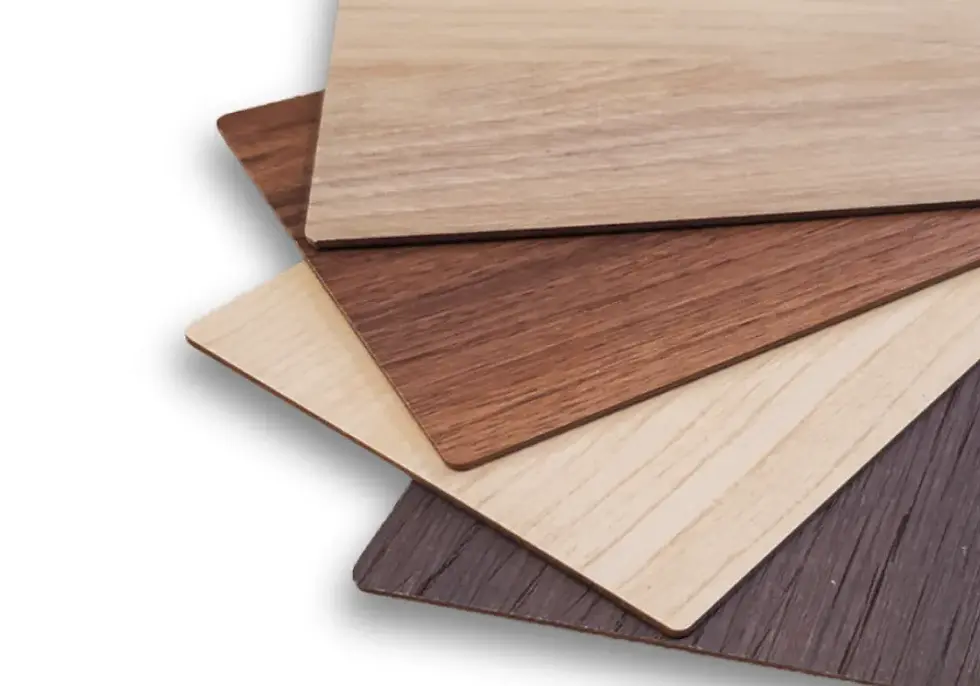Medium Density Fibreboard vs. Melamine-Faced Chipboard: Discover the Right Materials for Your Needs
- Agnes Gianni
- May 24, 2024
- 4 min read
Updated: Oct 27
Choosing materials for furniture and interior projects can be challenging, especially when two popular engineered wood options, Medium Density Fibreboard (MDF) and Melamine-Faced Chipboard (MFC), appear similar at first glance. Both are celebrated for offering excellent value and versatility in modern design and are found in everything from office desks to built-in wardrobes. Before starting your next project, understanding their true differences is essential.
Their internal structures are fundamentally different, and these distinctions dramatically affect their suitability for different environments, such as high-humidity kitchens versus low-wear living spaces. To ensure the durability and success of your project, you must look closely at their unique properties and performance characteristics. This deep dive into MDF vs Melamine Faced Chipboard will help you make an informed decision.

Understanding MDF and MFC
Medium Density Fibreboard (MDF) and Melamine-Faced Chipboard (MFC) are commonly known wood engineering products. You are likely to find cabinets, tables, and wardrobes made of these materials. Both offer affordability, a smooth finished surface, and a vast array of colors and textures. Yet, beneath the surface lie key differences that can make or break your projects. So, which one is good between MDF vs Melamine Faced Chipboard?
At first glance, you might notice the MDF’s high density and heavier weight, whereas the MFC has a rougher texture and feels lighter in your hands. The MDF is made of wood fibers pressed together with resin and high pressure. Though made using similar methods, the MFC uses wood chips and is finished off with melamine paper to give it an extra layer of protection and color.
Key Differences Between MDF vs Melamine Faced Chipboard
To make an informed choice for your project, you must look closely at how MDF and MFC fundamentally differ. These distinctions go beyond just the outward appearance; they impact how the boards are made, how well they resist wear, and where they perform best. The crucial variations lie in the material used for the core, the structural integrity of the finished board, the quality of edges and surfaces, and ultimately, the environments each is suited for.
1. Core Material and Composition
The first key difference between MDF vs Melamine Faced Chipboard lies in its constituent materials. MDF uses wood fibers at its core, often wood shavings taken from previous wood processing projects. These are pressed together using high pressure and resin. Meanwhile, MFC is made from wood chips pressed together with resin and finished off with a layer of melamine to give it a finer look. These differences will greatly determine the characteristics and appropriate use of the materials. MDF might be suitable for longer-lasting projects, while MFC might be good for smaller projects that require a unique texture or color from the melamine paper.
2. Density and Overall Strength
When it comes to density, the MDF tends to be denser than the MFC, thus stronger as well. A higher density contributes to material durability as well as how much easier it is to cut the materials without having to worry about them being easily broken or damaged. This difference in core structure is a key factor in determining MDF vs Melamine strength for any structural application or long-term project.

3. Surface Finish and Edge Quality
Even without the additional beautiful finish that melamine paper adds to boards, the MDF already has a smoother surface compared to the melamine board. This is due to the wood fibers that make up the Medium-Density Fibreboard. The fibers are smaller and finer compared to the chips of MFC, creating a more uniform and even surface compared to the chipboard, which is directly coated with melamine. In the comparison of MDF vs Melamine Faced Chipboard, it cannot be denied that the addition of melamine paper increases the MFC’s resistance to scratches and stains from heavy usage.
4. Application and Moisture Resistance
Performance-wise, these two panels each have their advantages in certain areas. The MFC’s melamine coating makes it the ideal choice for tables, shelves, and surfaces that are frequently in contact with people. On the other hand, the MDF’s high density allows for high moisture areas such as the bathroom or kitchen, where liquids are more likely to touch the surface of the materials.
Matching Medium Density Fibreboard and MFC to Your Specific Needs
After examining the core differences in composition, density, and application, choosing between MDF vs MFC should now be simpler. The ideal decision depends entirely on your project's environmental exposure and budget. For cabinetry, trim, or detailed routing work where shaping is key, MDF material is generally superior because its consistent structure of fine wood fibers provides smooth edges and better moisture resistance.
Conversely, if your project involves large, flat surfaces like shelving, internal dividers, or office desks where the surface will face daily wear and tear, the Melamine vs MDF choice leans toward MFC. The pre-finished melamine layer on chipboard offers excellent scratch and stain resistance at a lower price point. Ultimately, both materials are high-quality forms of engineered wood; the winning material is the one whose unique properties best align with the demands and lifespan required by your specific furniture design.
Both MDF boards and MFC have their advantages and disadvantages. The MDF’s high density allows for more durable cabinets, wardrobes, and other wood projects compared to those made using MFC. However, if you tend to move from place to place, using MFC-based furniture will allow you to easily arrange and pack products without hassle.
If you are looking for MDFs made from the best quality materials and resin to create superior furniture, be sure to take a look at our catalog over at PT Sumatera Prima Fibreboard (SPF) or visit us at www.spf.co.id.



Comments